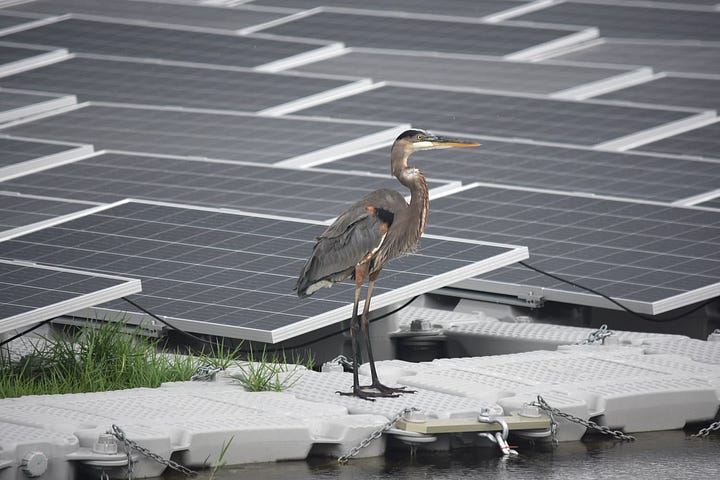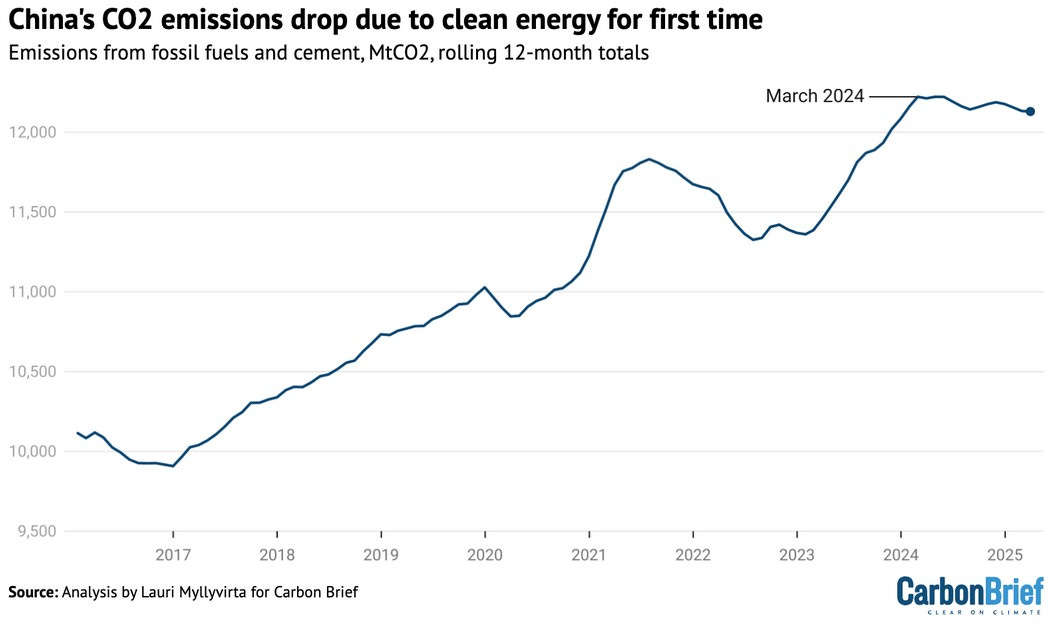The Weekly Anthropocene, May 21 2025
The conservation paradox is very common, China's CO2 emissions drop, manatees in Brazil, solar in Niger, sunflower sea stars, the northern white rhino genome, Romania's election, Superwood, and more!
The Big Picture: Immigrant Species

A landmark new study from Germany has made great strides in quantifying the conservation paradox, an increasingly common Anthropocene situation where a wild creature is endangered in its native homeland but is simultaneously considered introduced or “invasive” in some other part of the world. (Check out my highly controversial in-depth article on this!) Fascinatingly, they calculated that a massive 27% (!) of all naturalized plant species worldwide (“naturalized” here being a less judgmental term for “introduced” or “invasive”) were also considered threatened in their native range. The conservation paradox is really common!
The lesson is clear: the overwhelming majority of non-native species (not all1) aren’t a conservation enemy - they’re the biosphere’s best method of keeping species alive somewhere on a fast-changing planet. Embrace the Hemsworth Principle, folks!
China
A new data analysis has found that carbon dioxide emissions from all of China peaked and started to decline in the last year, with emissions down by 1.6% year-on-year from January-March 2024 to January-March 2025. China’s CO2 emissions have declined for a year — and it happened while electricity demand increased substantially! While China’s power demand grew by 2.5% over the last year, fossil fuel-burning power generation fell by 4.7%, with solar, wind, batteries, nuclear, and hydropower meeting the rise in demand. A historic turning point — and thanks to the ongoing gigantic Chinese cleantech build-out, this time the emissions peak is likely just the beginning of a long-term structural emissions decline. SPECTACULAR news!
China’s solar companies are continuing their expansion into more and more overseas markets, with new agreements planned to manufacture more solar panels in Ethiopia and sell more solar panels in Europe. Decarbonization will happen unexpectedly fast!
China’s Tiangong open-source and fully electric humanoid robot platform, a model of which recently completed running a half-marathon, has now demoed versatile complex-environment object-manipulation abilities at a trade convention, including serving fruit, sorting tableware, collecting waste, and more. China plans to rapidly scale up mass production of humanoid robots starting this year.
Brazil
In the village of Barra do Mamanguape on the northeastern coast of Brazil, the local population of manatees (Trichechus manatus) were traditionally hunted for food. But beginning in the 1980s, community conservation efforts have reoriented the village culture to protect manatees, sparking a lucrative ecotourism boom and saving around 60 beach-stranded manatees since the 1990s. Another great example of mutually beneficial human/wildlife coexistence in the Anthropocene!
Brazilian scientists have found that a type of microalgae can remove antibiotic residue (an emerging pollutant problem) from wastewater. A promising line of inquiry!
Niger
Solar panels are an increasingly common sight in the sunny African nation of Niger, which spans the Sahara and Sahel regions and is one of the most impoverished countries in the world. (Check out my article on Niger’s grassroots agroforestry boom and recently-ended democratic period). Cheap panels from China are now accessible to ordinary Nigeriens and even a small one can power phone chargers, lightbulbs, a fan, or drinking water pump — enough to change a life. At the grid scale, the ruling Nigerien military junta is reportedly building a 19 MW solar farm near Agadez and considering a larger 200 MW project. Another epic solar boom in the making! Superb.
Canada
The giant sunflower sea star (Pycnopodia helianthoides) is critically endangered, with their population devastated in the 2010s by a wasting disease spread by too-warm waters across North America’s Pacific coast. The species’ population is estimated to have declined by over 90% since 2013. Now, researchers have found thriving colonies of sunflower sea stars in the cool-water fjords of British Columbia, Canada, while captive breeding endeavors to produce disease-resistant sea stars. Great news!
Kenya

The northern white rhino (Ceratotherium simum cottoni) subspecies is famously “functionally extinct,” with only two living individuals, both female, living at the Ol Pejeta Conservancy in Kenya. Now, a new effort has mapped the genome of the northern white rhino. Critically, this will enable “quality control” checks on the induced pluripotent stem cell lines (capable of becoming egg or sperm gametes) that researchers have created with the hope of eventually gestating new northern white rhino embryos and saving the species, as well as making it easier to use tools like CRISPR editing. Amazing work, right on the edge of conservation and de-extinction!
Kenya’s government is accelerating efforts to deploy clean cookstoves across the country, with $400 million in new investments planned to help replace the burning of charcoal, which produces hazardous smoke and drives deforestation. Great work!
Researchers in Kenya have developed an AI prediction system to forecast and provide early warning of childhood malnutrition. The system analyzes records from 17,000 Kenyan health facilities plus satellite photos of crop productivity to predict outbreaks of malnutrition with 86% accuracy up to six months in advance, enabling faster and better-targeted responses. Fascinating work with amazing global potential!
Romania
The presidential election for Romania held on May 18, 2025 was won (in a thrilling upset victory!) by pro-EU, pro-NATO, and anti-corruption centrist independent mathematician mayor candidate Nicușor Dan, defeating the extreme far-right, anti-renewables, and MAGA-aligned candidate George Simion. Among many other positive effects, President-elect Dan’s victory means that Romania’s fast-progressing renewables build-out (1.7 GW of solar installed in 2024, plus plans for grid-scale batteries and a solar panel factory) will likely stay on track or accelerate! Great news.
Middle East & North Africa
A new report highlights the rapid growth of solar manufacturing in the Middle East and North Africa (MENA) region, particularly in Saudi Arabia, the United Arab Emirates, Oman, and Egypt. This newsletter had reported on the emerging trend!
This growth includes manufacturing across the value chain at the wafer, cell, and module (panel) levels, and is primarily driven by investment from Chinese companies. “MENA” could entirely supply its own domestic solar deployment needs by 2026, and could be manufacturing 44 GW of solar modules by 2029. The Solar Age spreads!
United States
The governing Republican Party is attempting to pass an absolutely atrocious and woefully destructive federal budget that would sadistically defund healthcare and social safety net programs, moronically defund and hobble America’s fast-growing clean energy industries by repealing almost all of the Inflation Reduction Act, and dangerously balloon the national debt — all to pay for even more tax cuts for the rich. Despite this world-historically stupid endeavor2 (which we can absolutely still stop!) people across America still strive and innovate to build a brighter future.


A new study from UC Davis has provided some of the first research on interactions between birds and the fast-growing clean energy field of floating solar. The researchers observed positive interactions between floating solar setups and many species, including waterbirds from cormorants to herons using floating solar as a resting site and black phoebes nesting under the panels. Alongside offshore wind farms becoming artificial reefs and desert solar farms nurturing plants with shade and a windbreak, this makes another great example of cleantech/wildlife coexistence!
The current presidential administration has finally lifted their arbitrary and capricious stop-work order on the already-permitted Empire Wind 1 offshore wind farm in New York State waters, allowing construction to restart!
General Motors has announced plans to mass-produce a groundbreaking new type of lithium manganese-rich (LMR) batteries for use in their Ultium electric vehicle platform. They claim that their LMR batteries will be 33% more energy-dense than the current gold standard of lithium iron phosphate batteries. Full production is set to start in 2028 at their Ultium factories in Ohio and Tennessee, with the resulting LMR batteries to be used in future SUVs and pickup trucks. If they can pull this off while surviving U.S. anti-cleantech policies, this could become a truly revolutionary development, actually outpacing China on battery innovation for once! A big deal.
This writer’s home state of Maine continues to lead the nation on heat pump adoption, with a new energy efficiency plan offering new incentives to accelerate heat pump deployment! It also includes demand-response programs to pay consumers for using less electricity at peak times, lowering prices across the grid. Excellent work!
In an incredible first-ever biomedical advance (one of many these days!) a U.S. research team has developed and administered a personalized CRISPR gene-editing therapy that saved the life of baby KJ, born in 2024 with a rare genetic disorder called CPS1 deficiency. Genetic engineering saves human babies, folks! The future is bright.
Leading driverless car company Waymo now sells 250,000 paid trips per week across four major U.S. cities, with plans to expand to three more in 2026. Now, they’re planning to expand their fleet still more, recently announcing a new factory in Arizona set to build thousands of Jaguar I-PACE electric SUVs modified to function as fully autonomous Waymo robo-taxis. Operating data shows that Waymo cars appear much safer than human drivers. Safe, clean, convenient transport: great work!
A fascinating new field of cutting-edge super-strong enhanced wood products is emerging in America, providing a new building material as strong as concrete but with much lower carbon emissions. Startup InventWood just raised $15 million to build a factory to mass-produce their “Superwood” product (invented in Maryland3) which is 10 times stronger than steel thanks to a multi-step heating, compressing, and chemical reaction process that reconfigures the structure of its cellulose molecules. At an earlier stage of innovation, researchers in Florida have successfully introduced nanocrystalline iron directly into the cell walls of red oak planks, a new method of making super-strong wood. Very promising work!
Please note this clear caveat - I am very much not in favor of the small minority of invasive species (often disease species and/or rats on fragile island ecosystems) with very clear negative effects. But it’s becoming clearer and clearer that these are, in fact, a small minority of non-native species, with even many classic examples of “invasive species,” especially plants and vertebrates on continents, turning out to be not that bad after all once we see their long-term effects after the locals have a decade or so to adapt. Much like in human politics where the far right misleadingly demonizes immigrants based on a few “criminals,” the overwhelmingly majority of “immigrant species” are neutral to beneficial!
Maybe during a historical moment when a peer superpower competitor (China) is rapidly scaling up the interwoven and highly synergizing battery-powered new technologies of grid-scale clean energy, weaponized drones, electric cars, humanoid robots, and more, it’s not the best idea for the U.S. to sabotage its own formerly-preeminent research-industrial complex over culture-war nonsense and ideological fever dreams? Just a thought.











As always, so appreciate this curation of positive news. Thank you! And a caveat: in my experience there's a pretty important difference between naturalized and invasive species. Naturalized species thrive in a new environment without causing ecological harm or squeezing out native species. Invasive species actually do harm, competing and harming native species.
I loved hearing about baby KJ.
I was almost hit by a driverless car in SF a month ago, so I remain skeptical. It came right for us in a crosswalk.